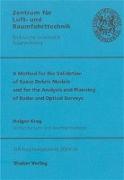- Start
- A Method for the Validation of Space Debris Models and for the Analysis and Planning of Radar and Optical Surveys
A Method for the Validation of Space Debris Models and for the Analysis and Planning of Radar and Optical Surveys
Angebote / Angebote:
TOday, mission planners fully rely on space debris models to assess the mission risk for spacecraft. To increase the reliability of these models they need to be validated by all available measurement data. Currently, ground-based optical and radar sensors provide most of the required data. However, these data are subjected to the geometrie constraints and selection effects as weil as to the sensitivity of the instruments.
The scope of this work is the definition, development and application of a tool for the validation of debris models using all available measurement data and accounting for all the stated problems. This tool is called PROOF (Program for Radar and Optical Observation Forecasting). PROOF simulates the measurement campaigns, considering all details of the instrument and the campaign using the space debris model as input. By this, PROOF is able to transform and filter the space debris population into simulated measurement results. In a comparison of simulated and real results for each campaign deficiencies in the model can be detected and traced back to their origin. In order to correlate detected objects with the USSPACECOM catalogue a high precision simulation for the prediction of acquisition times and pass characteristics of TLE objects is possible with the tool.
The PROOF software itself consists of three major components: A geometry filter to filter the population with respect to objects that cross the sensor's field of view during the campaign, an optical performance model to reflect the sensitivity of telescopes and a radar performance model to reflect the sensitivity of radar sensors. The optical performance model also contains a sophisticated night sky model describing the direction dependent background radiation. The mathematical and technical decomposition of these components is described in detail in this work. The output of the three components is validated by means of measurement data and the results of other tools. Parameter variation techniques are used to study important dependencies between the parameters describing instrument and campaign.
Finally, the performance and application of PROOFwithin its routine and also particular tasks is demonstrated: PROOF is applied for the validation of the new ESA-MASTER 2001 space debris model population. With the help of the tool a number of deficiencies in the debris model are detected and eliminated. It is demonstrated how PROOF can effectively support the interpretation of measurement results e.g. by complementing them with parameters inaccessible to the instruments, such as origin of objects, exact path and diameter. The large set of input parameters allows the definition of any existing or planned ground- or space-based radar or optical sensor. Hence, PROOF can also be used for the planning of observation campaigns and in the design phase of future instruments, which is demonstrated by several examples.
Libri-Titel folgt in ca. 2 Arbeitstagen
